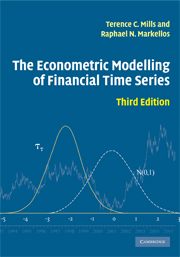Book contents
- Frontmatter
- Contents
- List of figures
- List of tables
- Preface to the third edition
- 1 Introduction
- 2 Univariate linear stochastic models: basic concepts
- 3 Univariate linear stochastic models: testing for unit roots and alternative trend specifications
- 4 Univariate linear stochastic models: further topics
- 5 Univariate non-linear stochastic models: martingales, random walks and modelling volatility
- 6 Univariate non-linear stochastic models: further models and testing procedures
- 7 Modelling return distributions
- 8 Regression techniques for non-integrated financial time series
- 9 Regression techniques for integrated financial time series
- 10 Further topics in the analysis of integrated financial time series
- Data appendix
- References
- Index
9 - Regression techniques for integrated financial time series
Published online by Cambridge University Press: 05 June 2012
- Frontmatter
- Contents
- List of figures
- List of tables
- Preface to the third edition
- 1 Introduction
- 2 Univariate linear stochastic models: basic concepts
- 3 Univariate linear stochastic models: testing for unit roots and alternative trend specifications
- 4 Univariate linear stochastic models: further topics
- 5 Univariate non-linear stochastic models: martingales, random walks and modelling volatility
- 6 Univariate non-linear stochastic models: further models and testing procedures
- 7 Modelling return distributions
- 8 Regression techniques for non-integrated financial time series
- 9 Regression techniques for integrated financial time series
- 10 Further topics in the analysis of integrated financial time series
- Data appendix
- References
- Index
Summary
Chapter 8 has developed regression techniques for modelling relationships between non-integrated time series. As we have seen in earlier chapters, however, many financial time series are integrated, often able to be characterised as I(1) processes, and the question thus arises as to whether the presence of integrated variables affects our standard regression results and conventional procedures of inference. This question is long-standing, since it has been known since Yule (1897) that an unremoved deterministic time trend could produce erroneous regression results by acting as a common but non-causal influence behind otherwise independent time series. Later, Yule (1926) was the first to explore directly the problem of ‘nonsense correlations’, arguing that these resulted from violations of the assumptions behind linear correlation, in particular that of serial independence. Through analytical examples, Yule showed that estimated correlations can be significantly biased if the underlying variables are polynomials of time. He also performed a set of impressive hand-calculated Monte Carlo experiments that demonstrated that nonsense correlations could also arise when analysing the relationships between pairs of I(1) or I(2) variables. Soon afterwards, Slutsky (1937) and Working (1934) were able to argue that random walk processes could produce conspicuous, yet erroneous, cyclical behaviour. Indeed, Working (1934, p. 11) expressed a view that, unfortunately, was ignored for many years: ‘Economic theory has fallen far short of recognising the full implications of the resemblance of many economic time series to random-difference series; and methods of statistical analysis in general use have given these implications virtually no recognition.’
- Type
- Chapter
- Information
- The Econometric Modelling of Financial Time Series , pp. 329 - 387Publisher: Cambridge University PressPrint publication year: 2008



